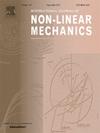Exact large deformation and stress analysis of shrink-fit multi-layer thick-walled/sandwich pressurized hyperelastic cylinders
IF 3.2
3区 工程技术
Q2 MECHANICS
International Journal of Non-Linear Mechanics
Pub Date : 2025-04-07
DOI:10.1016/j.ijnonlinmec.2025.105112
引用次数: 0
Abstract
The analytical closed-form solutions reflect the exact form of the dependency on the parameters and exhibit higher accuracy, extremely shorter computational times, and more problem-specific consistency in comparison to the finite-element-based results of the commercial computer codes, especially in the presence of constitutive, large deformation, and contact nonlinearities. In the present study, an analytical solution is proposed to treat the even more complicated problem of pressurized Mooney-Rivlin hyperelastic multilayer/sandwich cylinders that are composed of prestressed/shrink-fitted layers made of distinct hyperelastic materials. In contrast to the approximate finite element commercial computer codes, the material incompressibility and continuity conditions of the interfacial radial displacements and stresses can exactly be incorporated in the developed closed-form exact formulation. Moreover, an adaptive Newton-Brent robust numerical technique is employed to solve the resulting highly nonlinear equations. After verification of the results, the sensitivity of the resulting distributions of the deformations and radial, hoop, and axial stresses as well as the interfacial jumps in the hoop and axial stresses, against the stacking sequence of the layers, magnitude of the internal pressure, differences in the materials and thicknesses of the layers, and especially, the magnitudes of the shrink-fits are discussed in detail. Moreover, the influence and the effectiveness of the shrink-fit magnitude on the reduction of the resulting maximum hoop stresses are evaluated for different internal pressures. Results show that while proper shrink-fit values may mitigate the peaks of the interfacial hoop stresses of the compound multilayer hyperelastic cylinder, excessive magnitudes may lead to premature failures. Moreover, the shrink-fit/interference may lead to more uniform stress distribution and thus, more efficient pressure vessels from the design point of view.
收缩配合多层厚壁/三明治加压超弹性圆柱体的精确大变形和应力分析
解析闭式解反映了参数依赖关系的精确形式,与商业计算机代码基于有限元的结果相比,解析闭式解具有更高的精度、更短的计算时间和更针对具体问题的一致性,特别是在存在构成、大变形和接触非线性的情况下。本研究提出了一种分析解决方案,用于处理更为复杂的受压穆尼-里夫林超弹性多层/三明治圆柱体问题,该圆柱体由不同超弹性材料制成的预应力/收缩配合层组成。与近似的有限元商业计算机代码相比,所开发的闭式精确公式可以准确地纳入界面径向位移和应力的材料不可压缩性和连续性条件。此外,还采用了自适应牛顿-布伦特稳健数值技术来求解由此产生的高度非线性方程。在对结果进行验证后,详细讨论了所得到的变形和径向、环向和轴向应力的分布,以及环向和轴向应力的界面跃变对层间堆叠顺序、内压大小、层间材料和厚度差异,特别是收缩拟合大小的敏感性。此外,还评估了在不同内压下,收缩缝大小对减小所产生的最大箍应力的影响和效果。结果表明,虽然适当的收缩拟合值可以减轻复合多层超弹性圆柱体的界面箍应力峰值,但过大的收缩拟合值可能会导致过早失效。此外,从设计角度看,收缩配合/干涉可使应力分布更加均匀,从而提高压力容器的效率。
本文章由计算机程序翻译,如有差异,请以英文原文为准。
求助全文
约1分钟内获得全文
求助全文
来源期刊
CiteScore
5.50
自引率
9.40%
发文量
192
审稿时长
67 days
期刊介绍:
The International Journal of Non-Linear Mechanics provides a specific medium for dissemination of high-quality research results in the various areas of theoretical, applied, and experimental mechanics of solids, fluids, structures, and systems where the phenomena are inherently non-linear.
The journal brings together original results in non-linear problems in elasticity, plasticity, dynamics, vibrations, wave-propagation, rheology, fluid-structure interaction systems, stability, biomechanics, micro- and nano-structures, materials, metamaterials, and in other diverse areas.
Papers may be analytical, computational or experimental in nature. Treatments of non-linear differential equations wherein solutions and properties of solutions are emphasized but physical aspects are not adequately relevant, will not be considered for possible publication. Both deterministic and stochastic approaches are fostered. Contributions pertaining to both established and emerging fields are encouraged.

 求助内容:
求助内容: 应助结果提醒方式:
应助结果提醒方式:


